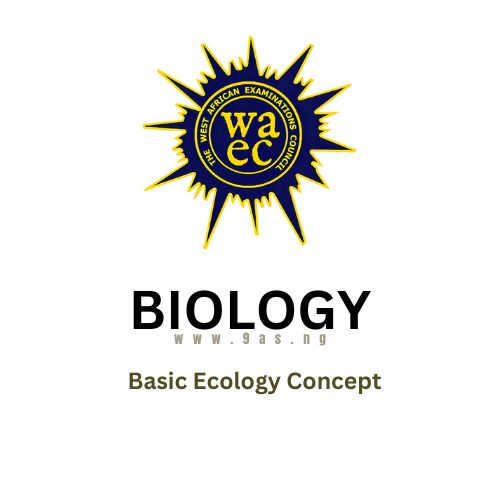OBJECTIVES
1. A space containing a group of interactive organisms is called
A. community. B. habitat. C. ecosystem. D. population.
2. The area around the earth where life activities go on is referred to as
A. biosphere. B. lithosphere. C. habitat. D. ecosystem
3. Which of the following components make up an ecosystem?
A. Decomposers, animals and non-living factors. B. Living and non-living factors. C. Plants and non-living factors. D. Plants, decomposers and non-living factors.
4. Which of the following natural resources is most readily available to all organisms?
A. Oil. B. Water. C. Air. D. Food.
5. Which of the following is a biotic component of an ecosystem?
A. Soil. B. Rainfall. C. Light. D. Fungi.
6. The difference between a community and population is?
A. a community is made up of organisms of the same species while a population is made up of organisms of different species. B. a community is made up of populations of living organism while a population is made up of organisms of the same species. C. an ecological niche does not exist in the community but it does in a population. D. a community attracts competition but a population does not.
7. A community is best defined as
A. living things in a habitat interacting with the non-living part of the environment. B. the total number of individuals of one species of organisms living in a particular habitat. C. populations of different species living together and interacting with each other in one habitat. D. the individuals of a particular group living together in an area and sharing the same resources.
8. Ecology simply means the study of A. particular species of plants and animals. B. the interrelationship between organisms and their environment. C. the properties of a habitat. D. the interrelationship between plants and animals.
9. In ecology, a community refers to
A. à number of individual of a given species. B. groups of different organism living in a habitat. C. existing species in an abandoned farmland. D. the dominant species in a habitat.
10. The term community is defined as
A. the different groups of plants and animals in the same area and interacting with each other. B. the consumers and producers living in a habitat. C. living organisms interacting with physical factors of an environment. D. animals which mutually derive benefit from their association.
11. The natural dwelling place of an organism is called its
A. ecological niche. B. habitat. C. population. D. environment.
12. In a particular habitat the role of an organism is referred to as its
A. level. B. biomass. C. niche. D. space.
13. The entire habits and habitat of an organism can be described as its A. ecological community. B. ecological niche. C. habitat factor. D. biotic factor.
14. The phenomenon whereby some organisms get established in an environment after struggling for existence by taking advantage of some special features possessed by the organism is called
A. partial selection. B. artificial selection. C. natural selection. D. competition.
15. Ecology simply means the study of
A. the properties of a habitat. B. interrelationship between organisms and their environment. C. several species of plants and animals. D. interrelationship between plants and animals.
16. A climax community is characterised by
A. a stable composition of plant and animal species. B. rapid changes in the composition of species. C. constant changes in appearance of the habitat. D. different species occurring at different times.
17. All the available places on earth which support life constitute the
A. lithosphere. B. atmosphere.. C. biosphere. D. hydrosphere.
18. Which of the following statements is not true of a climax vegetation? It
A. is an ecological phenomenon. B. is a stable community. C. eliminates competition. D. results from succession.
19. Ecology is best defined as the study of
A. the characteristics of an environment. B. the inter-relationship between living organisms and the environment. C. living organisms in a particular area. D. the habitats and wildlife.
20. Which of the following statements is not true of population?
A. Members of a population may be of the same species. B. Members of a population may be of
the same species but do not interbreed. C. Size of a population may be limited by space. D. Some species can form another population elsewhere.
21. A population is best described as
A. a group of the same species of the organisms living together. B. a group of animals and plants living together. C. a group of insects and grasses. D. different species of animals.
22. A stable self-sustaining environment produced by an interaction between the biotic and abiotic components is best described as
A. a niche. B. a community. C. an ecosystem. D. a habitat.
23. Biosphere is best described as
A. all parts of the earth where life exists. B. the non-living parts of an ecosystem. C. all components of an ecosystem. D. all the members of a single species in a habitat.
24. The group of several populations that interact and share a habitat, form
A. a species. B. a community. C. an ecotype. D. a tribe.
25. The term ecosystem refers to
A. different groups of green plants in a habitat. B. living members of a habitat. C. living organisms interacting with the physical environment. D. members of particular plants and animals living in a habitat.
26. The complex relationship between the members of a community and their physical environment is known as
A. commensalism. B. symbiosis. C. saprophytism. D. ecology.
27. The specific role of a species within its environment is known as its
A. habitat. B. niche. C. trophic level. D. biotic community.
28. Plants and animals of an ecosystem make up a
A. habitat. B. succession. C. community. D. population.
29. A group of organisms of the same species living in a particular place is known as
A. colony. B. community. C. ecosystem. D. population.
30. A group of organisms belonging to different species that coexist in the same habitat and interact is referred to as
A. population. B. biosphere. C. niche. D. community.
THEORY
- Describe briefly the interactions between abiotic and biotic components of an ecosystem
- Explain Population.
- Explain the following terms: (a) biosphere (b) population (c) community (d) ecosystem
- Explain briefly the following ecological terms: (a) biosphere (b) habitat
- (a) List three components of an ecosystem. (b) Describe briefly the interaction among the components named in (a)
- (a) Define the term hydrosphere (b) Give three examples of hydrosphere
- What is a habitat?
- Write short note on the following: (a) habitat; (b) ecological niche
- What is an ecosystem?
- Write short note on the ecosystem?
- (a) (i) What is an ecological niche? (ii) State five roles played by a mango tree in its ecological niche.



